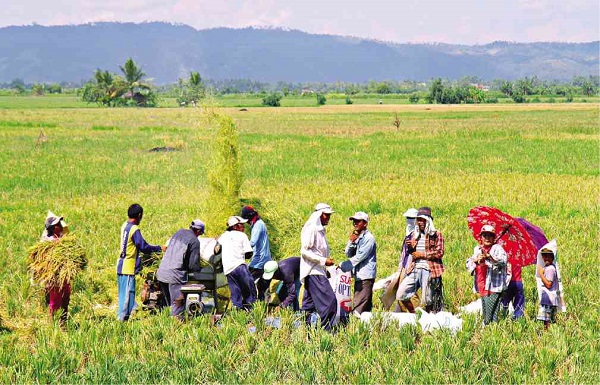Export of PH heirloom rice triples, says firm

FACED with the reality that the lion’s share of their harvest will go to landlords and high fertilizer costs, a farmer’s family in Camarines Norte province helps in the harvest to save on labor cost. DELFIN T. MALLARI JR./INQUIRER SOUTHERN LUZON
TALAVERA, Nueva Ecija, Philippines—The country has tripled its production of heirloom rice for export two months before its target date and is expected to export more before the year ends.
“We have already exported more than 300 metric tons to different countries,” said Dante Delima, agriculture undersecretary and coordinator of the national rice program.
“[That volume was] three times more than our target of 100 MT to be exported this year,” he said on Thursday at the warehouse and processing center of SL Agritech Corp. here.
Delima was a guest at the send-off program for the six container trucks of rice for export to Dubai in the United Arab Emirates. The exports produced by SL Agritech were intended to determine how Philippine rice would be received by other countries, he said.
“We will be exporting 100 MT more of premium and colored rice, including the heirloom rice of the Cordillera, this year,” Delima said.
The black and red rice varieties, he said, were produced in North Cotabato province. The commodity has been certified as organic and the volume already exported has reached 100 MT.
The reception to Philippine rice exported to Dubai, Singapore, Kuwait, Hong Kong, Germany, Macau, Canada and the Netherlands had been good, he said, although the government’s rice export program still had to be evaluated.
A basic question that needs to be addressed is: Will rice export be beneficial to farmers?
Delima said the first rice export by the Aquino administration was sent to Singapore in July, with a total volume of 45 MT. It fulfilled the rice demands of 146,000 Filipino workers in that country.
The Singapore export was followed by shipments of 35 MT to Dubai, 15 MT to Kuwait and Hong Kong, and 11.5 MT to Germany, Macau, Canada and the Netherlands. The rest of the exports went to the United States and other countries.
The series of exports represented the first rice shipments to other countries in 40 years, Delima said.
SL Agritech had produced about 900 MT of premium rice, which was packaged under the “Doña Maria” brand, said Michelle Lim-Gankee, a company official.
The good news comes amid the filing of a bill that seeks to increase government subsidy for fertilizers in the House of Representatives.
Militant farmers’ groups in Quezon province welcomed the bill’s filing, saying its approval would ease the burden on farmers brought by the high costs of fertilizers.
“We’ve long been demanding full government subsidy for agriculture production but that proposed 50-percent subsidy also would bring help to long suffering farmers,” said Antonio Flores, secretary general of Kilusang Magbubukid ng Pilipinas, in a phone interview.
On Wednesday, Laguna third district Rep. Sol Aragones filed House Bill No. 3252, also known as the Rice Fertilizer Subsidy Act of 2013, which seeks to provide qualified farmer-beneficiaries a 50-percent government subsidy for fertilizers.
Aragones cited a Department of Agriculture report that said fertilizer prices threatened rice production.
Romeo Clavo, head of Ugnayan ng Magsasaka sa Gitnang Quezon, also welcomed Aragones’ bill, which he said would be a big help to farmers.
“Most of us buy fertilizers at P1,300 a sack. Half of the money would mean a lot to the farmers,” Clavo said.
The Philippine Rice Research Institute estimates that fertilizers account for 20 percent of total rice production cost, requiring at least eight bags per hectare.
Socioeconomic Planning Secretary Arsenio Balisacan has said lack of government subsidy prevented growth in farm productivity and employment, reducing the earnings of poor farmers and landless workers, and making food more expensive.
The government has yet to increase subsidy for agricultural inputs and preferred to pay taxes for rice importation.
In 2013, the National Food Authority (NFA) paid some P1.7 billion in duties and taxes for the importation of rice under a government-to-government arrangement.
Last April, the NFA imported some 205,700 MT of rice from Vietnam. The transaction is currently under investigation by both the Senate and the House for allegations of overpricing to the tune of at least P400 million. With a report from Delfin T. Mallari Jr., Inquirer Southern Luzon
